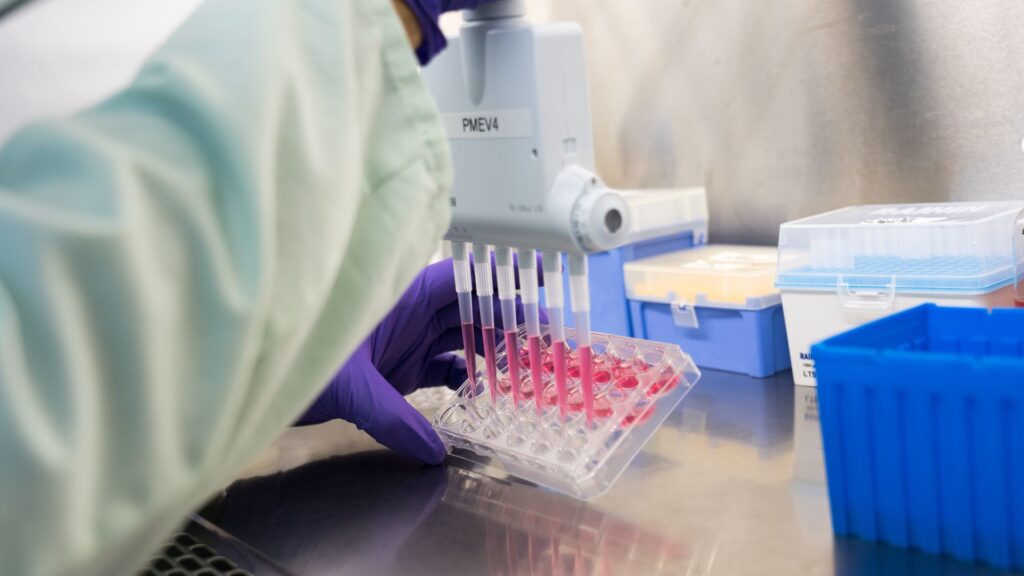Biocompatibility
BioTox by Icare offers all the medical device biocompatibility studies required by ISO 10993 standards, from cytotoxicity to tolerance, implantation and haemocompatibility studies, etc.
BioTox by Icare evaluates the biocompatibility of Medical Devices in accordance with ISO 10993.
Table I of ISO 10993-1 classifies medical devices according to the nature and duration of their contact with the human body, and lists the tests applicable to each type of medical device.

BioTox by Icare offers:
- A preliminary study of your file and guides you in the choice of your testing strategy.
- Advice and expertise: risk analysis, Biological Risk Assessment, worst-case strategy, evaluation of your file, interpretation of physico-chemical test results according to ISO 10993-17.
Thanks to their compliance with Good Laboratory Practices (GLP) and current standards, the reports of these studies can also be used for certification (CE, FDA, Japan, etc.).
- Cytotoxicity according to ISO 10993-5 (XTT, Trypan Blue, Neutral Red, etc.)
Irritation:
- Evaluation of skin irritation on healthy or damaged skin in rabbits according to ISO 10993-23 (single or repeated application)
- Evaluation of irritant effect on vaginal, anal, nasal and cheek mucous membranes in rabbits according to ISO 10993-23
- Evaluation of eye irritation in rabbits according to ISO 10993-23
- Evaluation of intradermal tolerance in rabbits according to ISO 10993-23
- Evaluation of skin irritation on reconstructed epidermis model according to ISO 10993-23
Sensitisation:
- Skin sensitisation in guinea pigs according to Buehler according to ISO 10993-10
- Skin sensitisation in guinea pigs according to the Magnusson and Kligman method according to ISO 10993-10
- Skin sensitisation in mice: lymph node stimulation tests: LLNA-BrdU according to ISO 210993-10
Evaluation of acute systemic toxicity in rodents:
- Intravenous according to ISO 10993-11
- Intraperitoneal according to ISO 10993-11
- Oral according to ISO 10993-11
- Dermal according to ISO 10993-11
- Subacute toxicity in rats (4 weeks) according to ISO 10993-11 (OECD 408)
possibly combined with implantation testing, according to ISO 10993-6 (in accordance with the 3Rs principles)
- Subchronic toxicity in rats (12 weeks) according to ISO 10993-11 (OECD 408)
possibly combined with implantation testing, according to ISO 10993-6 (in accordance with the 3Rs principles) - Chronic toxicity in rats (26 weeks, 1 year) according to ISO 10993-11 (OECD 452)
possibly combined with implantation testing, according to ISO 10993-6 (in accordance with the 3Rs principles) - Study of pyrogenic effect in rabbits according to ISO 10993-11 according to USP, European Pharmacopoeia and Japanese Pharmacopoeia.
In vitro haemocompatibility (human blood) according to ISO 10993-4
- Haemolysis
- PTT determination
- Study of complement system activation (SC5b9)
- Platelet activation test (PF4)
Mutagenicity and genotoxicity according to ISO 10993-3 and ISO/TR 10993-33
- Tests for reverse mutations in “Salmonella typhimurium his-” and “Escherichia coli” or Ames test (based on OECD 471)
- In vitro study of chromosomal aberrations in mammalian cells (human lymphocytes, CHO) (based on OECD 473)
- In vitro gene mutation tests in mammalian cells (L5178Y) (based on OECD 490)
- In vitro micronucleus test in mammalian cells (CHO) (based on OECD 487)
Implantation in rats according to ISO 10993-6
- Subcutaneous or intramuscular, (4 weeks)
- Subcutaneous or intramuscular (12 weeks)
- Endosteal (12 weeks or 12 months or 18 months)
- Biodegradation: in vitro and in vivo study according to ISO 10993-9 and ISO 10993-13,-14,-15 (subcontracting)
- Carcinogenesis in rats according to ISO 10993-3 (OECD 451) (subcontracting)
- Reproductive and developmental toxicity (OECD 415, OECD 416, OECD 414, OECD 421) (subcontracting)
contact us
models
- Osteoblasts and bone marrow osteogenic stem cells
- Adipocytes (and stem cells)
- Normal chondrocytes (and chondrogenic stem cells) and osteoarthritis chondrocytes
- Endothelial cells (and stem cells)
- Ligament fibroblasts
- Human lens epithelial cells
biomaterial contact studies
- From adhesion to colonisation (integrins, cytoskeleton, SEM)
- Cell proliferation
- Cell differentiation (synthesis of the extracellular matrix and specific proteins)
- Pro-inflammatory cytokines

